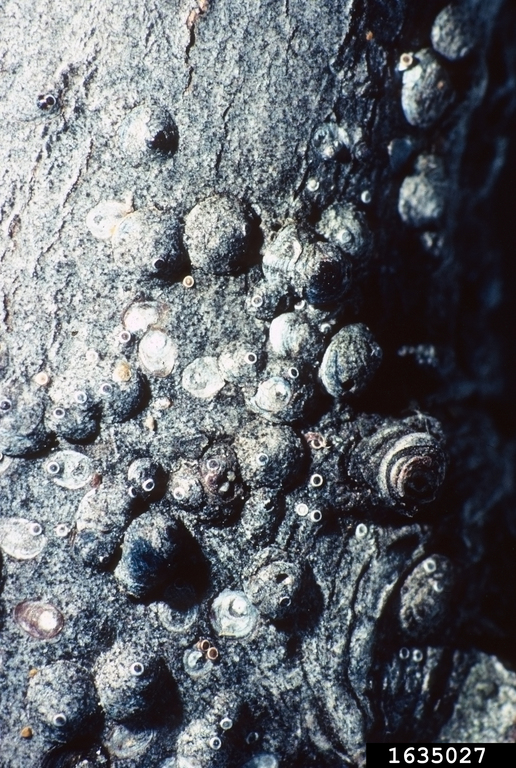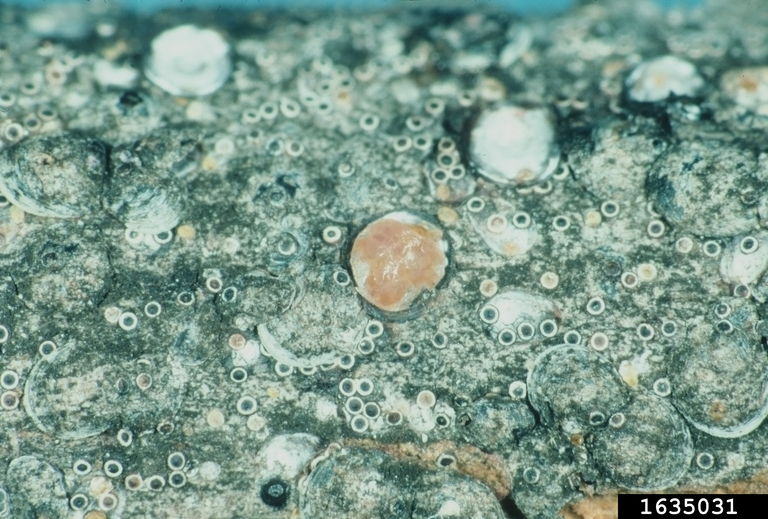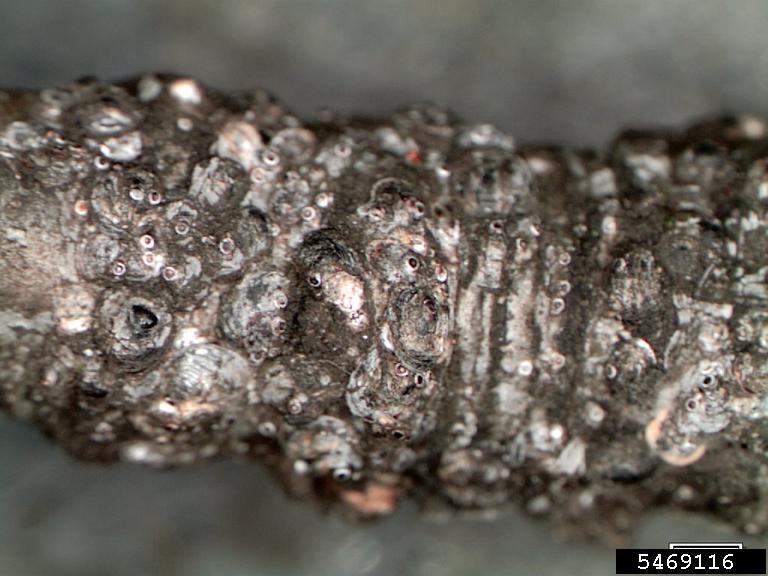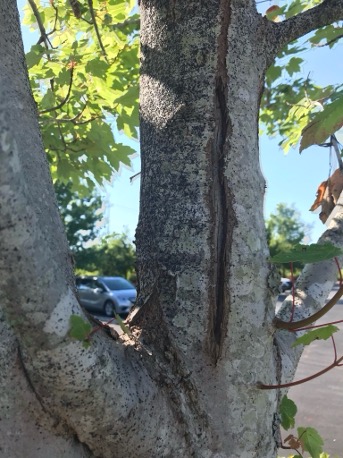Gloomy scale (Melanaspis tenebricosa; Figure 1) is a serious insect pest that affects maple trees in urban Georgia. It can go undetected for years. Affected trees can show branch dieback and canopy thinning after 6–10 years, when the population reaches extremely high densities. A waxy shield covering protects females from predators and insecticide exposure, and usually gives them a convex shape.
The armored scale wax covering on the bodies of gloomy scale can be detached using a knife. This is different than soft scales, such as wax scales, which are glued to the females’ bodies. Gloomy scales do not produce honeydew, also unlike soft scales. Female gloomy scales have piercing and sucking mouthparts that look like tubes that are inserted into the parenchyma cells (cells that synthesize and store trees’ organic products) in the epidermal layer of tree bark. Male gloomy scales do not have mouthparts. The black and gray dust that deposits on tree bark makes scale detection even more challenging over time, as they camouflage to the color and texture of the bark. This is especially true for trees planted along right-of-ways and parking lots.

Figure 1. Gloomy scale insect on red maple bark.
Photo: John A. Davidson, University of Maryland, Bugwood.org.
Description and Biology
Gloomy scale nymphs develop through three stages to become adult females and five stages to become adult males. Females are round (with concentric rings/ridges) with a darker center, although their color can vary (Figure 2). Adult females are sedentary, but males have wings, which they use to fly to find their mates. The adult female appears pink- or cream-colored when their waxy covering is removed (center of Figure 2). Females may live 12 months, whereas males live only 4 months. The adult female is about 1.5 mm in diameter and has no legs or antennae. Oval-shaped males are smaller than females.
During their lifetime, gloomy scale females produce 70 oval-shaped eggs that measure 0.15 mm wide and 0.25 mm long. They are produced in clusters over an 8-week period. The eggs develop and hatch within the females and emerge as crawlers. These emerging crawlers seek feeding sites within 30 cm of their mother. Crawlers are the only nymphal stage with legs, eyes, and antennae. Once they settle on feeding sites, they feed and secrete the waxy covering on their bodies (Figure 2). Gloomy scale insects experience one generation per year. Mated females overwinter, and crawlers emerge in spring. Gloomy scale crawlers emerge over 6 weeks, unlike other scale insects, which have a distinct emergence period. Females reproduce both with and without (parthenogenesis) mating. For gloomy scales, reproduction without mating is believed to be more common than after mating. Insects in the crawler stage can be dispersed by wind and foraging insects and animals (such as birds). The movement of infested trees might also contribute to dispersal, but this is not confirmed.

Figure 2. Adult and crawler gloomy scale insects on red maple bark. The cream-colored female shows the waxy covering removed.
Photo: John A. Davidson, University of Maryland, Bugwood.org.
Damage
The surface of tree bark becomes bumpy and has a grainy texture when it is infested by high densities (Figures 3 and 4). Young branches show dieback and thinning of the tree canopy. The dark-colored and bumpy bark surface, along with a thinned canopy of the infested tree, gives a dull or gloomy appearance. The infestation begins from the younger branches and progresses to the bark of older branches. The overall aesthetic value of landscapes deteriorates with infested trees. All affected trees eventually die.

Figure 3. Bark surface infested with gloomy scale insects. The waxy coverings of living and dead females pile up over several generations.
Photo: Eric Honeycutt, Bartlett Tree Experts, Bugwood.org.

Figure 4. Tree infested with gloomy scale insects.
Photo: Shimat V. Joseph, University of Georgia
Hosts
Gloomy scales can infest more than 28 woody plant genera, but red maple (Acer rubrum L.), silver maple (Acer saccharinum L.), and Freeman maple (Acer × freemanii A.E. Murray) are preferred hosts. Other hosts include boxelder (Acer negundo L.), sweetgum (Liquidambar styraciflua L.), holly (Ilex spp.), mulberry (Morus alba L.), sugarberry (Celtis laevigata Willd.), Osage orange [Maclura pomifera (Raf.) C.K. Schneid.], white ash (Fraxinus americana L.), tulip poplar (Liriodendron tulipifera L.), and lime prickly ash [Zanthoxylum fagara (L.) Sarg.].
Monitoring
Gloomy scale infestation management is often challenging and expensive, as scale infestation is not typically diagnosed until damage becomes severe. Interventions at this stage typically do not result in recovery of a clean, healthy tree. This is why monitoring for early infestation is critical after planting a tree. Red maple trees are especially at risk for infestation. To monitor crawlers, double-sided sticky tape can be attached around the branches. Trapped crawlers suggest an active population of gloomy scale. Because there is no threshold developed for management decisions, early intervention is warranted before the infestation becomes severe.
Management
A multipronged, integrated pest management approach is necessary for management of gloomy scale. Most scale insect crawlers are often targeted with contact insecticides, such as horticultural oil or pyrethroids, before or during peak emergence. This strategy may not be effective for gloomy scales, however, as crawler emergence is usually extended up to 8 weeks.
High temperatures and lack of irrigation increase the risk of rapid spread of gloomy scale infestation for urban trees planted around impervious surfaces, such as concrete or pavement. This is because gloomy scale reproduction increases with temperature.
Some predators (such as lacewings [in Chrysopidae, Hemerobiidae families], lady beetles [Coccinellidae], and parasitoid wasps) have been observed attacking gloomy scale nymphs, but notable control has rarely been noticed on infested urban trees. Power washing can mechanically remove gloomy scales, but effective control from this method is inconsistent.
Chemical management can be an important tool to suppress gloomy scale populations. Contact insecticides — such as horticultural oils and insecticidal soap —may suppress gloomy scale crawlers, but their effectiveness is questionable because of the prolonged emergence phase of crawlers in the spring (especially those products with reduced residual activity). Pyrethroids may offer better control on crawlers, as their residues persist a bit longer than oils or soap.
Systemic insecticides, such as neonicotinoids (dinotefuran, imidacloprid, thiamethoxam, acetamiprid, clothianidin) are generally effective against armored scales but have yet to be tested against gloomy scales. It is important to note that many recent field studies suggest that neonicotinoids can be present at lethal levels in flowers and may be harmful to foraging pollinators and other beneficial arthropods. Systemic insecticides should be repeatedly applied as a drench at a higher dose for effective control. This is because gloomy scales feed on the parenchyma cells instead of the phloem tissue and are likely exposed to lower doses of systemic insecticides. Read product labels, including precautionary statements, carefully before using any insecticides. Consult with a county agent for any current insecticide recommendations.
References
Dale, A. G., & Frank, S. D. (2014). The effects of urban warming on herbivore abundance and street tree condition. PLoS ONE, 9(7), e102996. https://doi.org/10.1371/journal.pone.0102996
Frank, S. D. (2012). Reduced risk insecticides to control scale insects and protect natural enemies in the production and maintenance of urban landscape plants. Environmental Entomology, 41(2), 377–386. https://doi.org/10.1603/EN11230
Morales, M. G., Denno, B. D., Miller, D. R., Miller, G. L., Ben-Dov, Y., & Hardy, N. B. (2016). ScaleNet: A literature-based model of scale insect biology and systematics. Database, 2016, 1–5. https://doi.org/10.1093/database/bav118
Just, M. G., Dale, A. G., & Frank, S. D. (2020). Gloomy scale (Hemiptera: Diaspididae) ecology and management on landscape trees. Journal of Integrated Pest Management, 11(1), 24. https://doi.org/10.1093/jipm/pmaa028
Larson, J. L., Redomond, C. T., & Potter, D. A. (2013). Assessing insecticide hazard to bumble bees foraging on flowering weeds in treated lawns. PLoS ONE, 8(6), e66375. https://doi.org/10.1371/journal.pone.0066375
Metcalf, Z. P. (1912). The gloomy scale, an important enemy of shade trees in North Carolina. Journal of the Elisha Mitchell Scientific Society, 28(2), 88–91. https://www.jstor.org/stable/24330532
Status and Revision History
Published on Oct 23, 2023


























































